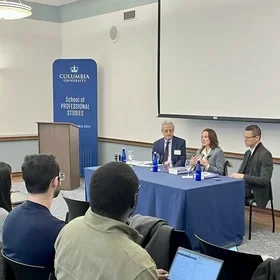By Steven Cohen, Ph.D., Director of the M.S. in Sustainability Management program, School of Professional Studies
The horror of the wildfires engulfing entire neighborhoods of Los Angeles brings home to all of us the growing danger of our warming planet. California has worked hard to improve its capacity to fight fires and has many rules designed to reduce the probability of the events we have seen in L.A. But nature is more powerful and less predictable than we might wish, and as I write this, we are still in the midst of a massive catastrophe. There will be conservative politicians blaming the liberals running California and Los Angeles for this disaster, and while I know that is irresistible in our politically polarized nation, I think it is important to avoid the blame game and instead focus on the lessons we must learn from this unbelievable tragedy. Some of those lessons may require the state to focus more on climate adaptation, something it can control, and reduce its emphasis on climate mitigation, something that requires national and global action.
It is not that California is unaware and unprepared for wildfires, but the ferocity of the current catastrophe makes it clear that we are in new and uncharted territory. In an excellent piece in the New York Times last week, Christopher Flavelle reported that:
“This week’s fires around Los Angeles present a puzzle: Why is California, the state best equipped to deal with wildfires, seemingly unable to prevent blazes from consuming entire chunks of the country’s second-largest city? California’s building code for wildfires is among the most protective in the nation. Its local fire departments are backed up by CalFire, the state fire agency, which has a $4 billion budget and some of the best trained firefighters in the world. The state’s huge tax base generates effectively unlimited resources for wildfire protection. And California has mandatory statewide requirements that homeowners in risky areas create “defensible space” around their property — rules that other Western states would like to apply but can’t because it would anger conservative voters. Yet the events of this week demonstrate the limits of those efforts, raising uncomfortable questions about whether any part of the United States — even the wealthiest, best prepared and most experienced — can truly adapt to wildfires made worse by a hotter climate.”
The fires in Los Angeles are not a unique, one-off event. They are among scores of recent extreme weather events that have destroyed homes and communities throughout the United States. Our system of predicting and responding to disasters is wildly under-resourced, and our method of reconstructing post-disaster is ad-hoc and incredibly insufficient. While FEMA can provide some short-term assistance to address immediate needs, as Heather Gillers reported recently in the Wall Street Journal:
“Uncle Sam can help with more than emergency assistance. But the newly seated, majority-Republican Congress will have to authorize this additional aid. The government’s Community Development Block Grant Program can hand out money to help repair and rebuild homes—as soon as Congress appropriates it. It took lawmakers about three months to set aside money after superstorm Sandy and almost a year and a half to approve funds to help rebuild Lahaina, Hawaii, the Maui town destroyed by wildfires in August 2023.”
The pain of catastrophe is compounded by the uncertainty that families face when trying to generate the resources for reconstruction. The trauma and disruption impact families, especially children who are unable to attend school or engage with their friends. The overall solution in the long run is mitigating climate change. This, of course, will take a generation to accomplish, but the impact of the warming planet must be understood and acted on. As the NOAA and NASA reported last week, 2024 was the hottest year on record here on planet Earth. While Trump’s “advisor” Elon Musk understands climate change, he considers its impacts exaggerated. Our incoming President still considers it a hoax and probably will continue to feel that way until his own properties begin to suffer from extreme weather events. But even if these fellas were committed to decarbonization, the transition will take decades, and meanwhile, we will still need to deal with the fires and floods that our warming planet is bringing.
We require a national mobilization with massive resources deployed to predict and respond to extreme weather impacts. We need to build more resilient structures designed to withstand whatever nature can throw at it, and, when even that is insufficient, we need to develop the capacity to clean up and reconstruct communities destroyed by extreme weather events. An America that can’t even enact intelligent and self-interest-driven immigration policy is unlikely to be capable of generating the tax dollars and technical capacity to meet this moment. We have the ingenuity and technological base to develop the capacity we need; we simply lack the political will and sense of urgency needed to do what is necessary. The public feels that taxes are too high, and I see no chance of generating the national response needed. The costs of extreme weather disasters are far from trivial. According to Adam B. Smith, published on the NOAA website:
“NOAA’s National Centers for Environmental Information (NCEI) has updated its 2024 Billion-dollar disaster analysis. In 2024, there were 27 individual weather and climate disasters with at least $1 billion in damages, trailing only the record-setting 28 events analyzed in 2023. These disasters caused at least 568 direct or indirect fatalities, which is the eighth-highest for these billion-dollar disasters over the last 45 years (1980-2024). The cost was approximately $182.7 billion. This total places 2024 as the fourth-costliest on record, trailing 2017 ($395.9 billion), 2005 ($268.5 billion) and 2022 ($183.6 billion). Adding the 27 events of 2024 to the record that begins in 1980, the U.S. has sustained 403 weather and climate disasters for which the individual damage costs reached or exceeded $1 billion. The cumulative cost for these 403 events exceeds $2.915 trillion.”
Keep in mind that the fires in Los Angeles are taking place in 2025, so our disaster cost count is off to a rapid start as the new year begins. The number of people impacted by extreme weather events is growing each year, and if you escaped losing your home in 2024, there is no guarantee you won’t be displaced in 2025. While some of the people displaced in Los Angeles have the financial resources to rebuild or relocate, many do not, and all are suffering from the trauma of losing their homes and, in many cases, their entire communities.
But the growing number of extreme weather events and the growing number of Americans suffering from these impacts does not seem to be large enough to generate the systemic response needed. In any given year, most Americans may experience extreme weather, but they do not lose their homes or communities and the inconvenience they experience is temporary. In the New York region, Hurricane Sandy took place over a dozen years ago. After a while, amnesia sets in. But we New Yorkers are not immune to the impact of another extreme weather event, which could come at any time. We need to reduce the ad-hoc, poorly thought-through process we follow when providing disaster relief. Our nation is rich enough to afford the cost of a national program to insure the cost of post-disaster home and community reconstruction. While we would want to develop a program that did not encourage people to live in places of high risk, we need to develop a system that facilitates reconstruction and does not leave it to the whims of our elected officials.
Just as we instituted Social Security to provide income for the elderly and Medicare to provide them with health care, we will need to develop a system to ensure that funds are available to rebuild homes and communities after disasters. This will require increased taxation. Private insurance can address routine and localized misfortune but cannot handle the financial burden of large-scale post-disaster reconstruction. Many home insurance companies are fleeing high-risk states like California and Florida. California’s over-regulation of the insurance industry has left the state program to back up private insurance (The FAIR program) over-exposed to risk and probably unable to handle the costs of the current catastrophe in Los Angeles.
At its core, America is a generous country, and Americans have great empathy for their neighbors in need. We all identify with the sadness and sense of loss we see in southern California, but our politics is incapable of transforming that empathy into a carefully thought-through, fiscally responsible system of home and community insurance. Someday, I believe we will meander into such a policy, but I’m afraid we will experience many more catastrophes before we arrive there.
Views and opinions expressed here are those of the authors, and do not necessarily reflect the official position of Columbia School of Professional Studies or Columbia University.
About the Program
The Columbia University M.S. in Sustainability Management program offered by the School of Professional Studies in partnership with the Climate School provides students cutting-edge policy and management tools they can use to help public and private organizations and governments address environmental impacts and risks, pollution control, and remediation to achieve sustainability. The program is customized for working professionals and is offered as both a full- and part-time course of study.



